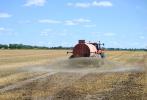
H2020 MultiSens Project: A revolutionary quality indicator platform for the food industry
- Type Project
- Status Filled
- Execution 2017 -2019
- Assigned Budget 170.121,6 €
- Scope Europeo
- Main source of financing Horizon 2020
- Project website MultiSens
- Correlation of meat freshness with gas concentration inside packaging (WP 1).
- Development of selective, stable and precise sensors for CO₂, NH₃ and H₂S (WP 2).
- Implementation of sensors in the packaging (WP 3).
- Smartphone application as a quality control/user feedback system (WP 4).
- Validation of the MultiSens platform as a quality system (WP 5).
MultiSens' goal is to develop a revolutionary quality indicator platform for the food industry. This innovative smart packaging platform will alert customers to meat quality, bringing value and benefits throughout the food supply chain. It will reduce waste, provide valuable information to the end user, and help Europe maintain a competitive edge in the market.
In the EU alone, food waste along the supply chain is estimated at approximately 89 million tonnes or 180 kg per capita per year, and is projected to rise to 126 million tonnes annually by 2020 unless action is taken. Households currently generate the majority of food waste in the EU (42%), and experts estimate that reducing food waste at the consumer level in developed countries by 30% could save approximately 400,000 km² of cropland by 2030.
Food products are typically packaged in a modified atmosphere (MA), which consists of a gas mixture optimized for the food being packaged. Monitoring the composition inside the packaging allows us to determine whether this MA has been constant or whether the product has already begun to deteriorate. However, a non-destructive method for determining this MA has not yet been reported.
This project proposes to exploit the development and integration of a multi-membrane sensor into meat packages using the imaging and communication capabilities of smart devices for freshness detection, while also employing innovative packaging methods for sensor integration. If the sensor is placed within or on the package in close contact with the headspace of the packaged meat, it will allow monitoring of key gases within its environment and transmitting information about the meat's quality. The economic and social impact of such a platform, even if it were to reduce food waste by 10%, would be significant.
The novelty of this project lies in the high-quality preparation of the sensors, innovative methods for their immobilization, and the simple, non-destructive detection method.
MultiSens' goal is to develop a revolutionary quality indicator platform for the food industry. This innovative smart packaging platform will alert customers to meat quality, bringing value and benefits throughout the food supply chain, reducing waste, providing valuable information to the end user, and helping Europe maintain a competitive edge in the market.
In the EU alone, food waste along the supply chain is estimated at approximately 89 million tonnes or 180 kg per capita per year, and is projected to rise to 126 million tonnes annually by 2020 unless action is taken. Households currently generate the majority of food waste in the EU (42%), and experts estimate that reducing food waste at the consumer level in developed countries by 30% could save approximately 400,000 km² of cropland by 2030.
Food products are typically packaged in a modified atmosphere (MA), which consists of a gas mixture optimized for the food being packaged. Monitoring the composition inside the packaging allows us to determine whether this MA has been constant or whether the product has already begun to deteriorate. However, a non-destructive method for determining this MA has not yet been reported.
This project proposes to exploit the development and integration of a multi-membrane sensor into meat packages using the imaging and communication capabilities of smart devices for freshness detection, while also employing innovative packaging methods for sensor integration. If the sensor is placed within or on the package in close contact with the headspace of the packaged meat, it will allow monitoring of key gases within its environment and transmitting information about the meat's quality. The economic and social impact of such a platform, even if it were to reduce food waste by 10%, would be significant.
The novelty of this project lies in the high-quality preparation of the sensors, the innovative methods for their immobilization and the simple and non-destructive detection method.
MultiSens has developed a novel, versatile, and efficient way to check meat freshness. This methodology can be used by companies to guarantee consumers that the product they purchase is in perfect condition, thereby improving product quality.
- UNIVERSIDAD DE GRANADA (UGR)







